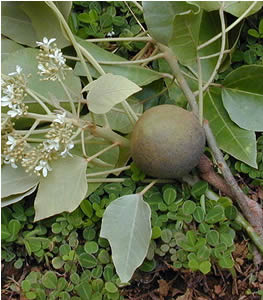Kukui Nut Oil Aleurites moluccanus

Kukui nut in a lei
- Common Names
- Kukui Nut Oil , Candlenut, Indian-walnut, candleberry
- Botanical Name
- Aleurites moluccanus
- Syn. Jatropha moluccana
- Family
- EUPHORBIACEAE
Medicinal Uses & Benefits of Kukui Nut Oil
![]() How to Use|
Side Effects |
Plant & Garden|
How to Use|
Side Effects |
Plant & Garden|
- Medicinal Uses: * Acne
* Burns
* Eczema
* Hair
* Polynesian
* Psoriasis
- Properties: * Emollient * Skin tonic
- Parts Used: Nut
- Constituents: vitamins a, c, and e, fatty acids: oleic- 25.5%, palmitic- 6.5%, alpha-linolenic- 25.1%, linoleic- 40%
How to Use: Kukui Nut Oil
Kukui oil is expeller expressed from the nuts, and is light yellow with an amber tint. The oil penetrates skin deeply to hydrate and soften and is used as an emollient in skin care. Kukui oil is used to treat a variety of skin ailments such as eczema, psoriasis and burned or damaged skin. Kukui is an excellent botanical source of fatty acids and antioxidants, as well as Vitamins A,C and E.
Preparation Methods & Dosage :This tropical wonder oil can be used in all types of body,skin and hair care. Kukui oil makes great addition to homemade creams and lotions,(add after any steps that require heat, and do not expose it to high temperatures). Use this rich oil sparingly alone for an oil treatment on dry hair and scalp, or add a few drops to your bath water.
 In the Kitchen: Kukui nuts are edible and the pounded nutmeats are used to make relishes for fish.
In the Kitchen: Kukui nuts are edible and the pounded nutmeats are used to make relishes for fish.
Kukui Nut Oil Side Effects: Kukui oil has a limited shelf life, so take care to store in a cool, dry place away from heat and light.
Plant Description
Kukui, Aleurites moluccana is the State tree of Hawaii,and grows in the rich soil of the lower slopes of the volcanos. The common name Candletree is from the practice of stringing together the nuts of the kuki and using them for torch-like lighting.
- Flowers/Fruit/Seeds:The round nuts hold the oil producing seeds that are used in skin care
- Plant Class:Flowering tree grows to heights of 80 ft., wide, spreading branches
- Rhizome:
- Leaves:Pale green, simple ovate, or trilobed.
- Preferred Habitat:t
- Flowering Season:
- Distribution:Tropical
Regional Traditions :Tropical islands *
History and Traditions & Folklore
The origins of the Kukui tree stem from Asia, and the Kukui was introduced to Hawaii by Polynesian seafarers. The nuts where lighted and used as 'candles' by in ancient Hawaii, which led to the English name Candlenut. The clear, lightly scented oil was used to anoint newborns and as a massage oil for royalty. Kukui bark is rich in tannins, and was used to tan leather hides, preserve fishing nets, and as an additive to wine to increase intoxication.1












